The iPhone 7 and iPhone 7 Plus Review: Iterating on a Flagship
by Joshua Ho & Brandon Chester on October 10, 2016 8:00 AM EST- Posted in
- Smartphones
- Apple
- Mobile
- iOS
- iOS 10
- iPhone 7
- iPhone 7 Plus
System Performance
Section by Brandon Chester
At the heart of a smartphone lies the SoC. While there's now an increasingly common belief that specifications don't matter, the truth of the matter is that almost all of the software features that users now take for granted in a smartphone have only been made possible by the continued improvements in hardware performance. Modern smartphones with high resolution displays and complex interfaces would not exist if the available CPU and GPU processing power hadn't advanced as much as it has. On top of that, performance is something of a gating factor for software development, as the innovation that happens in software has to happen within the boundaries of what can be done with the hardware. Specifications in a smartphone actually matter quite a lot, even if the user isn't actively aware of all the individual components that make up their smartphone's SoC.
With the iPhone 7 Apple doesn't have the benefit of a new major process node to help improve performance. Any improvements will be the result of architectural improvements, as well as improvements that have been made to TSMC's 16nm process since the release of the Apple A9, which was Apple's first FinFET SoC. It's important to note that one of the goals of A10 Fusion is improving dynamic range, so the focus isn't solely on improving performance. However, device performance seemingly must improve with each generation, and Apple is advertising a 40% improvement in CPU performance and a 50% improvement in GPU performance with A10 Fusion compared to A9.
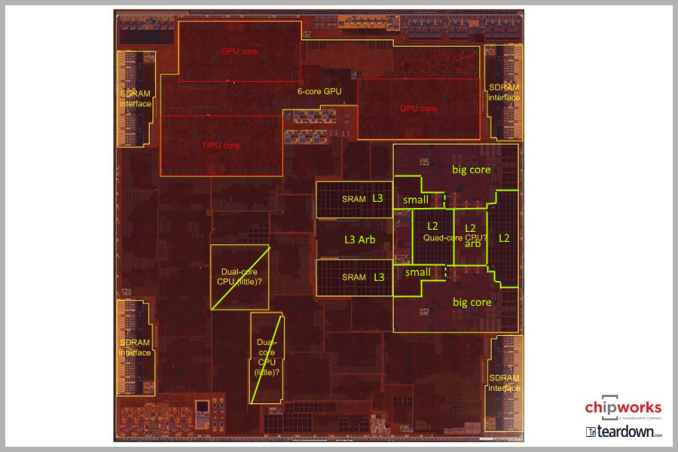
A10 Fusion's Floorplan (Special thanks to Chipworks)
While an in-depth look at A10 Fusion will have to wait until our seperate technology deep dive, we can still take a look at how performance has changed at a higher level. A10 Fusion's peak frequency is 2.3GHz, up from 1.8GHz on A9. This gives a theoretical improvement of 28% on its own, and the remainder will have to come from improvements to the architecture in Apple's (big) Hurricane cores. Based on our testing so far, Hurricane is not radically different from Twister (A9), but Apple has been making some optimizations. Meanwhile it should be noted that while A10 technically has four CPU cores – the two Hurricane cores and the two smaller cores – this is not a heterogeneous design, and only two cores are active at once. So for the purposes of high performance benchmarking, this means we're benchmarking the big cores nearly exclusively.
Anyhow, we've run our standard suite of benchmarks on the iPhone 7 and 7 Plus to see if A10 Fusion stands up Apple's performance claims.
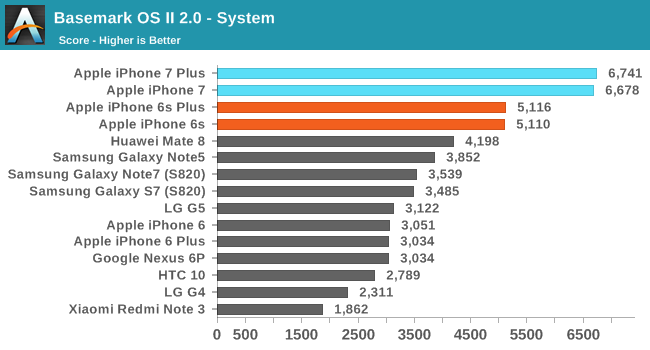
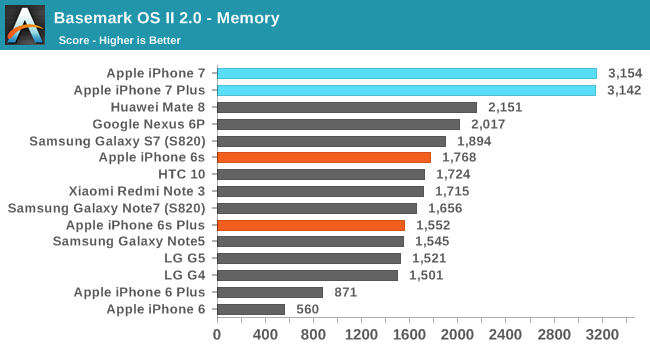
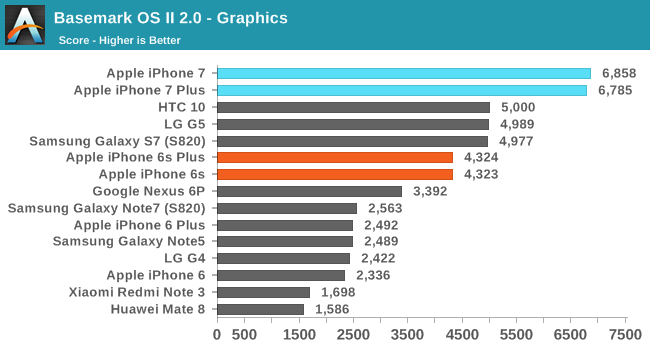
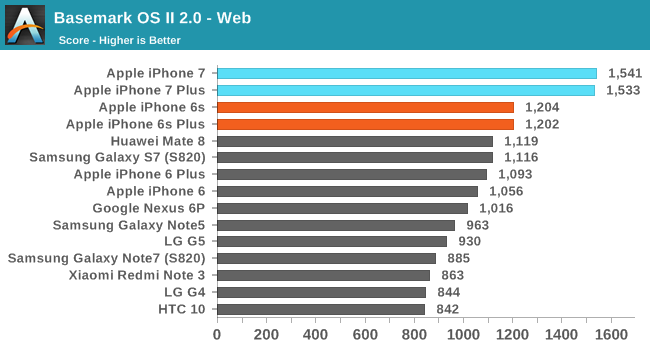

I've brought back BaseMark OS II for this review, although unfortunately the reason has less to do with wanting it back in the benchmark suite and more to do with there being very few cross-platform general system benchmarks nowadays. You can focus on the GPU, or the CPU, but the major system performance benchmark in mobile is PCMark and it remains exclusive to Android. BaseMark OS II is a pretty large optimization target now, and while it does test many aspects of the system it doesn't do so by directly simulating the tasks that a user would perform. Despite that, it helps in getting a holistic view of a device's performance by going beyond tests of a single component, so it's not without its uses.
The iPhone 6s and 6s Plus have remained the fastest overall devices in this test, so it's really just a matter of seeing how much Apple has improved. The latest generation of Android devices outpaced the GPU performance Apple's A9 SoC some time ago, so that's one area where Apple could stand to improve against the competition. As it turns out, they have. The iPhone 7 and 7 Plus show significant gains over their predecessors across the board. Performance in the system sub-test is up by 25-30%, and the graphics score is right in line with Apple's claimed 50% increase in performance. Web shows similar gains to system, which makes sense given that both are relatively CPU-bound.
The memory/storage test also shows a large improvement, which is interesting at first glance given that Apple didn't highlight any improvements in this area. However, this is just the result of the tested units being the 256GB model. On my retail iPhone 7 which is 128GB the memory score is essentially the same as the iPhone 6s which was also tested in a 128GB configuration. This comes down to the fact that these devices use a hybrid SLC/TLC storage solution, where the SLC storage can be used for writes and data can be moved later as needed. It's likely that on the 128GB iPhones the BaseMark OS II memory test is exceeding the size of the SLC cache, leading to lower scores based on the performance of the TLC NAND. On the 256GB iPhone the SLC cache is large enough to fit the entire data set used in the test, leading to a much higher score.
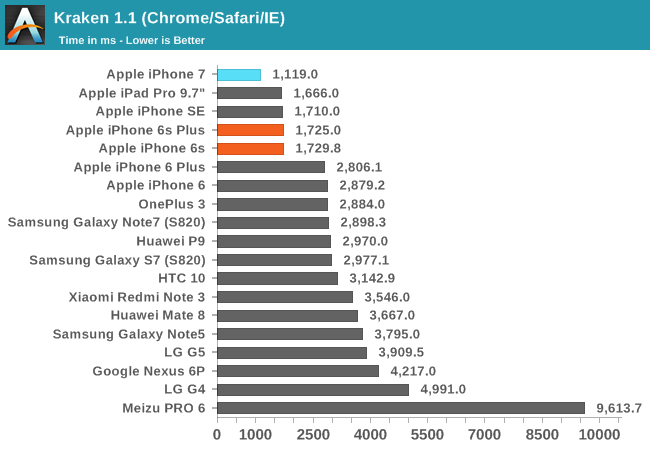
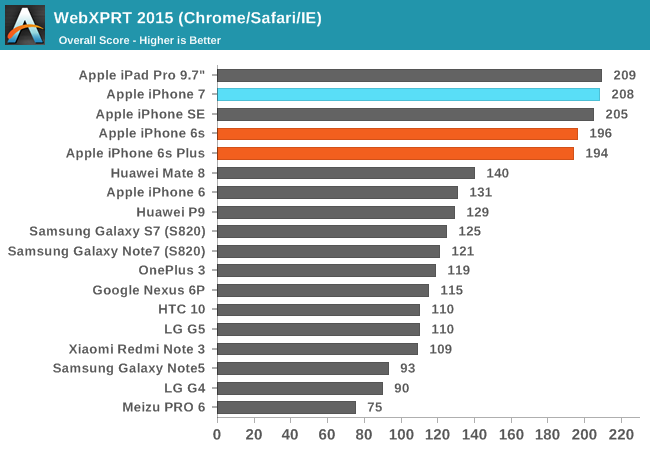
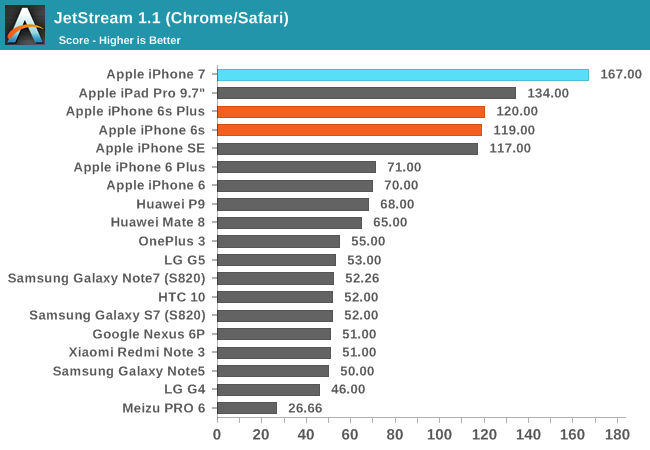
Web performance is an interesting case. While Apple's continued increases in single core CPU performance have benefited web performance with each generation, the truth is that improvements Mobile Safari's Nitro JavaScript engine have contributed a great deal as well. When looking at the charts you can see that there's a significant gap between the iPhone 7 and the next device, with the exception of WebXPRT where it's tied. What's more important than this gap is what the second device actually is. It's always another Apple device, and the same is true for the third device, and the fourth device, and so on. In Kraken and Jetstream the top seven devices on the chart are Apple's mobile devices, and the charts only have seven Apple devices in total. The Huawei Mate 8 is able to move ahead of the iPhone 6 in WebXPRT, but the gap between it and the iPhone 6s is still enormous. While Apple has continued to advance their web performance, it hasn't been with the immediate goal of beating the Android competition, as the best Android devices are still just trading blows with the iPhone 6.
WebXPRT is a small exception. As far as mobile benchmarks go, it's quite long and has short bursty workloads with pauses between each to simulate how a user would pause between different actions while using the browser. I suspect that in this case we're seeing the effects of A10 switching between its low power and high performance cores, causing parts of the test to be run on the little cores, which are not as performant. In fact, In the case of very quick actions that take only tenths or hundreths of a second to complete, it may not be possible to switch to the high performance cores before the operation has ended, causing the score to reflect the performance of the low power cores instead.
While it might seem reasonable to attribute the superior web performance of iOS devices to Apple's focus on improving single threaded CPU performance, the fact that Android devices with Cortex A72 CPUs are only matching Apple's A8 SoC shows that the gap is not only due to the CPU power available. Chrome's generally poor performance on Android is a significant limiting factor, and you can see in the chart how the improvement in Android device CPU performance over time has not translated into anything close to the sorts of gains that Apple has seen in the same period. While there are customized versions of Chromium like Snapdragon Browser that provide optimizations for a class of SoCs, it doesn't look like the gap between Android devices running Chrome and iOS devices running Mobile Safari is going to close any time soon, and if anything, it's only widening with each year.


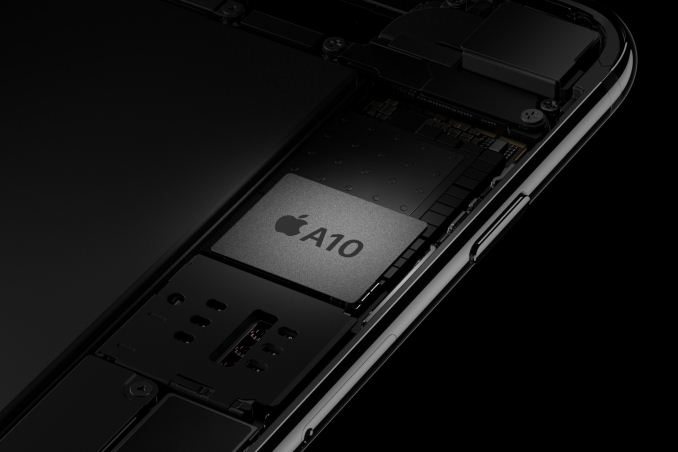








377 Comments
View All Comments
solipsism - Monday, October 10, 2016 - link
So you want legislation to artificially control smartphone prices and kill the free market. Brilliant¡If you graph the supply and demand for the iPhone you'll see that equilibrium price is actually lower than it could be. Meaning, Apple is actually losing money in the short term, but this isn't altruistic, but designed to help capture the market for the longterm, therefore increasing their overall profitshare. Economies of scale are already maxed out at it is.
The cost of components or what you perceive as the value of a smartphone is irrelevant—all that matters is what the market dictates. If you feel that high-end smartphones are too expensive, then don't buy them. They did release an iPhone SE because the market wanted a 4" model. If you and enough others stop buying smartphones in this price range you'll see that ARP drop. This happened in India.
jlabelle2 - Friday, October 14, 2016 - link
"They did release an iPhone SE because the market wanted a 4" model"Not at all. If it was the case, the sales of the iPhone 6 would not have been so huge compared to previous model.
The release the SE because they wanted to target people not willing to spend 750-850$ on a phone. The SE is selling mostly because it is half the price and the cheaper iPhone ever sold.
grayson_carr - Monday, October 10, 2016 - link
The price of iPhones has not risen. What are you talking about?grayson_carr - Monday, October 10, 2016 - link
The first iPhone was originally $599 subsidized with a two year contract, meaning over $1000 were it not for the subsidy, and the base model iPhone 3G was priced much lower at $599 full price without a contract, but that still equates to ~$670 today when you factor in inflation. So at a starting price of $649, the iPhone 7 is cheaper today than iPhones were 8 years ago accounting for inflation.StrangerGuy - Monday, October 10, 2016 - link
I didn't knew owning luxury goods is a fundamental human right.It doesn't matter much you stinkers try to hide your entitlement syndrome under the guise "for the greater good", you still get smelled a million miles away.
kogtsalami - Monday, October 10, 2016 - link
Small correction: The iPhone 4 was not made of aluminium but stainless steel.JoshHo - Tuesday, October 11, 2016 - link
The intent was to say that the iPhone 4 was one of the first smartphones to use external antennas integrated into the design rather than internal antennas embedded in RF windows.dsraa - Monday, October 10, 2016 - link
No mention of the audio performance through the new dongle? what about bluetooth sound?? I know this is a brief review, but at the very least their should be a section on audio and how it compares to the 6s since there it is now done through a digital 'adapter'???TechnologyGuy - Monday, October 10, 2016 - link
Sorry as usual with an iPhone review here - great on the details but illogical conclusions. The removal of 3.5mm headphone jack doesn't matter? That's a clear deal breaker for me, especially when AirPods for me literally belong in the garbage and having invested $1000's on headphones in the past. Not sure what you mean about the camera - iPhones have now barely caught up in quality, but clearly still lagging behind the S7 and Pixel. The iPhone 7 battery life is mediocore at best, and without fast charge or wireless charging - another automatic deal breaker for me. The screen is just passable in comparison to the competition.So really, the only thing that is industry-leading is the SoC, and I think at least for me, that hardly compensates for all the subpar areas. I am not sure why you are so obsessed with the SoC and system performance when the overall experience based on the components (at least those that matter in day-to-day usage - screen, camera, battery life/charging) is no batter than your average $300 phone. My experience with a phone does not depend how good I feel about the SoC under the hood. This phone is a clear no for me and not worth the $650-750 USD.
mrochester - Monday, October 10, 2016 - link
You're forgetting that you need to consider the OS and ecosystem too. A phone isn't just a bunch of hardware components, and it's an OS and software layer too, which is much more important than the hardware anyway.